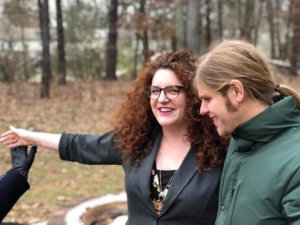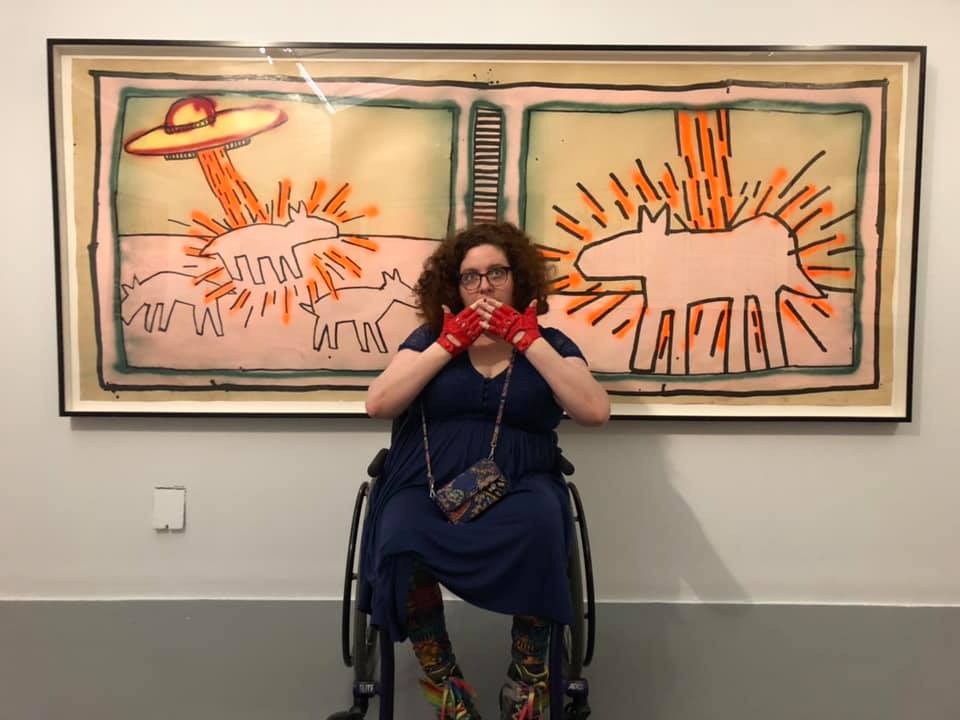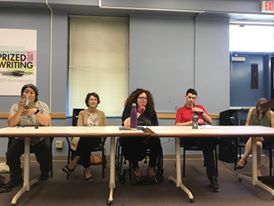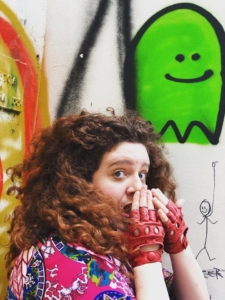By Dan Christmann
Jessica Stokes is a disability activist, performance artist, and scholar currently working on her Ph.D. at MSU. She’s also one of my favorite people in the whole world. I was lucky enough to catch up with her a few weeks ago, and have a conversation about disability, the environment, and the stories we tell about both. She lives with a rare disorder called Charcot-Marie-Tooth which causes muscle and sensation loss, especially in the hands and feet. The interview has been edited for length and clarity.
Dan: How did you start on the path you’re on today?
Jessica: So when I was in college, I wasn’t a disability rights activist. It wasn’t even a huge part of how I would identify myself. I grew up with a family that used “foot problems” as a euphemism instead of talking about my disability. And so coming from that sort of environment, I didn’t have a lot of disability identity.
Then, one summer I decided to do the U of M New England literature program. That’s like six weeks in Maine where you live like Henry David Thoreau.
I remember knowing that there was going to be hiking involved, but my family had been to some parks and things. I’d been able to do some paved hiking paths and even dirt ones that were kept pretty clean. And I thought I’d even gone up a mountain at one point, but like with steps, and so I just thought it was within my capacity.
Then I get there and they want my crippled a** to be Henry David Thoreau, which is not gonna happen. And I get to the first of three mountains we’re supposed to climb together and it’s supposed to be the easiest one. I could only make it to the foothill part and I was supposed to hike the whole way, and they didn’t really know what to do with me.
So at one point I just had to sit on the ground and say I wasn’t going anywhere. They didn’t know how to accommodate for disability in these natural spaces. It was that messy place, where the protection of my legal accommodations didn’t seem to make sense to anybody and I had to try to figure out what I needed, where I first realized this sort of overlap between thinking about disability and thinking about the environment. It was this weird disconnect between a rugged individualist mindset, my still enjoying this space that people didn’t seem to anticipate my body in at all, and them not knowing what to do.
Dan: This reminds me of the time we went to Muir Woods.
Jessica: Yeah, it has a bunch of spaces that are marked for being quiet. And my wheelchair, it’s loud. And people just want to turn around. They’re ready to shush me. And then they’re like, “s**t”. They’re like, “I don’t know what to do morally in this situation because I still want you to be quiet but I probably can’t tell you.” Yeah, and then other folks also will cheer me on. Just some folks are so surprised to see a disabled person in an environment that they’ve deemed as a separate nature space. Sometimes there are audible gasps.
Dan: Yeah, and we went to that trail, and Mike and I had to handle the wheelchair through all those trees.
Jessica: We decided to do it specifically because it had a sign that said no strollers.
Dan: That was a time and a half. I feel like there’s a reticence to make places like that accessible because we’re afraid that they’ll change, or you’ll destroy the environment. Even though the things that are really destroying the environment are not like, putting in a ramp somewhere, right?
Jessica: There’s a book by a scholar called Alison Kafer I’m reading. She talks specifically about the National Park in the Everglades where people were terrified about making it more accessible. They ended up building this platform above the swamps. It actually made it so people who were taking steps were doing less damage to the landscape as well, because they were now elevated. They weren’t likely to step on any species that needed protecting, and it was more accessible for people. So it’s just weird that a path that a walker can use is deemed not harmful to nature. But if you put a wheelchair there, well, that’s a real problem.
Dan: What area of things are you working on right now?
Jessica: Right now I’m looking at representations of disability and animals and popular culture. What I mean by that is that often disabled people when they’re growing up find themselves compared to animals as an insult. So their bodies are seen to move like animals. They’re said to be closer to something sort of less than human.
People do it as an insult, maybe because they’re insulting nature as a as a starting place and seeing that as something they’ve carved themselves off from or away from. They place the disabled person “out there”. And so a lot of disabled activists and thinkers are like “rather than get rid of this other space we’ve been placed in, what if we re-imagine its boundaries and what it means to be considered as part of that space .” But it’s also been a violent practice to be placed there. So there are some people that are reasonably resistant.
Dan: Do you think that this difficult relationship with nature makes it hard for some disabled people to engage with it?
Jessica: Sure. Like in the trip I took to Maine, the space of nature in some people’s eyes made it easier for them to justify their lack of accommodations for me. A friend of mine is in India right now doing a research project for a piece that we’re going to do something with later together, and one of the folks that he’s meeting with leads Outdoor Adventure trips specifically for disabled people. He’s a disabled person himself. He created it because he didn’t feel like there was sort of room for him in these traditional narratives.
I think there are a lot of people that don’t feel welcome in nature, because they haven’t seen themselves in it. I know for me one of the first pieces that really hit me hard about this was an article about the plastic straws.
Dan: Oh yeah!
Jessica: David Attenborough’s Blue Planet came out and that everyone worried about plastic straw pollution, which I believe it’s very low on the totem pole of what ocean pollution is existing out there. And yet it was gone after vehemently.
So many disabled people aspirate if they don’t have straws to use, if they have to drink straight out of the glass, and straws have become really inaccessible. One of my friends told me that they asked for one and they were told, because their disability is not apparent, that they were not going to get one and that they were bad for asking and that they were hurting our environment.
There are lots of people out there who can be in on this environmental movement, but if you demonize them, they’re not coming along. How do you change the frame of the environmental movement so that it’s not just attacking the easiest target? I know disabled people who are told they should feel deep guilt if they buy pre-cut vegetables.
Dan: Do you think this has something to do with the rugged individualist mentality you were talking about before?
Jessica: Yeah, because a lot of disabled people are interdependent.
It’s like whenever there’s a device or a thing that makes [it] a little bit easier in some way people, are like “who the heck would need this? They should be able to take care of themselves,” and they haven’t even imagined that could be a disabled person on the other side.
Interdependence is, like, a lot of disabled people already need help to live, but they provide help that society doesn’t recognize or notice. So in my relationship with my partner Michael, we have sort of mutual support back and forth. There are these beautiful things like him tying at my laces every day that are a small part of our life. But some people would say it is him only taking care of me, and miss the emotional time spent together, even support that goes back the other direction, because their notion of independence is tying your own shoes every time. From like eight on you’re supposed to be able to do that, or you’re not a good girl or a grown-up.
I think that’s a flaw with getting disabled people to join in. Disabled people themselves are pointed at as the sort of negative alternative if you don’t help. Like “if we don’t take care of this thing, you will become disabled. What a horrible life.”
Or it’s like, so what happened in Flint is absolutely terrible. But if you’re imagining only that lead poisoning leads to disability, and disability is the end of the world, then what happens to them now? What kind of narrative about the environment can we have that doesn’t just wait for some future where those kids have grown up, and then another generation gets to be without blood poisoning? How do we make sure that their lives are valued and that they’re not written off in the stories we tell about how to do something about the state of the world?
Dan: I feel like this myth of independence thing leads to a lot of guilt, shame, and negativity for a lot of people.
Jessica: Ecological lament. I have a friend who does environmental justice law right now. He’s been just reading statutes all summer and became super depressed about his own environmental usage. He’s become very self-hating about all the things. He feels like he should just stay right around his area and bike everywhere. That should be his life, because otherwise he feels bad. And I know a lot of folks of this generation also report having anxiety or depression around the environment.
Dan: For me, that seems counter-intuitive. Not that you can do anything about that, but we hyper-focus on the little things that we can do until it gets paralyzing. It would be a lot better if we could find a way to feel good about ourselves when we act, as opposed to feeling bad if we don’t.
Jessica: I do have to think about the scale of resistance versus the scale at which our capitalist economy and western thinking are continuing to produce more and more and more at this particular moment. And the scale of that seems much bigger than something I could correct or save as a single individual.
It seems like the way this sort of resistance has to happen is via, you know, people who are interrelated. I would hope that there’s some way to hold the sadness, because there’s a reason to feel it for sure, but to also be working towards something else and not just totally giving up.
I know with some of my performance art I’ve been trying to think of how to make people see these points of relation. When I was at UC Davis, there was this one bridge that was just very hard for me to get over in my wheelchair. It was in the Arboretum. So it was in a space that’s sort of been deemed natural. But somehow it is allowed to have these two quite steep hills on either side of a river bridge that my wheelchair had to go down every day, because I live behind this building and it was the fastest way to campus by like 10 or 15 minutes.
When I would go down it, my chair would go like loose and wild because of how steep it was. People would have to sort of move out of the way.
So one of my small performance pieces was just to go up and down either side of this bridge for two hours, just back and forth. People would sometimes ask to push the chair, people would react in a scared way because they heard the noise of the chair, or they were worried about me falling into the river. I do think that it engaged us in this precarious space together in some sort of way.
The point is that other people are involved in these spaces too. I try to get people to interact with each other to make them realize our involvement together, even in the small things that could seem like your own personal burden.
Dan: Making people realize they’re not alone?
Jessica: And that other people use the spaces differently, and how maybe that’s not such a bad thing.




